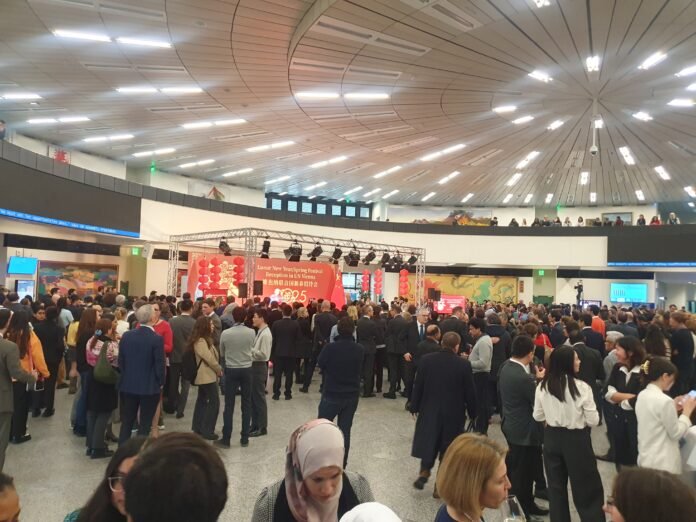On 21 January 2025, the Vienna International Center was filled with vibrant colors and lively sounds as the Chinese Festival took place at the UN ROTUNDA. The air was filled with the melodies of traditional music, providing a harmonious backdrop to the grand celebration. The event featured an array of delicacies, offering a taste of China’s rich culinary heritage.
The festival was not just about food and music; it was also a platform for sharing and celebrating Chinese culture. Several speeches were delivered, highlighting the essence of Chinese traditions and the country’s commitment to global openness. These addresses emphasized the importance of cultural exchange and mutual understanding in fostering international relations.
The UN ROTUNDA was transformed into a festive arena, with decorations and performances that showcased the beauty and diversity of Chinese customs. Attendees were treated to a spectacular display of dance, martial arts, and other cultural performances, each telling a story of China’s historical and contemporary influences.
The celebration was a testament to the enduring spirit of cultural diplomacy, illustrating how festivals like these can bridge gaps and build connections between nations. The Chinese Festival in Vienna was not just a celebration of heritage but also a vivid expression of China’s outreach and engagement with the world.
Historical Significance of the Spring Festival
The Spring Festival, known as Chunyun, holds a profound significance in Chinese culture, reflecting centuries of traditions and historical evolution. Its roots can be traced back over 4,000 years, originating from ancient agricultural practices that marked the end of winter and the arrival of spring, a season essential for sowing and harvesting. This period was celebrated to acknowledge the cycle of nature and the rejuvenation it brought. Over time, the festival has undergone several transformations across different dynasties, adapting to the changing societal values and cultural norms.
Symbolism and Meaning of the Spring Festival
The Spring Festival, commonly known as Chinese New Year, represents a significant cultural event in China, encapsulating rich symbolism that resonates with themes of renewal and hope. One of the most prevalent symbols associated with this festival is the arrival of spring itself, which signifies a turning point after the dormant winter months. This transition is reflective of a new beginning, as nature awakens with the promise of life and vitality. The Spring Festival embodies the hope for prosperity and good fortune, themes that are deeply ingrained in the collective consciousness of the Chinese people.
Cleaning the house ahead of the Spring Festival is a customary practice that carries profound meaning. This act signifies the removal of misfortune and bad luck accumulated over the past year, thereby making way for good luck and positive energy in the new year. Families engage in thorough cleaning as a ritual to reset their living spaces, symbolizing a fresh start. Furthermore, the act of purchasing new clothes also serves as a metaphor for new beginnings, indicating readiness to embrace the opportunities that lie ahead.
The festival also emphasizes the importance of worshipping deities and honoring ancestors, reflecting the deep-rooted cultural values of respect and remembrance. Families come together to offer prayers and sacrifices, seeking blessings for health and prosperity. This practice illustrates the reverence towards familial bonds and the continuity of traditions that is integral to Chinese culture. Additionally, the significance of reunion dinners, held on the eve of the Spring Festival, reinforces the idea of familial unity and connection, where members gather to celebrate and share hopes for the future.
In conclusion, the symbolism and meaning of the Spring Festival encompass not only the celebration of the new year but also highlight themes of renewal, family unity, and cultural heritage. Each tradition and custom associated with the festival contributes to its rich tapestry, offering insights into the values cherished by Chinese society. Through these practices, the Spring Festival emerges as a vibrant expression of hope and collective aspirations for the forthcoming year.
Celebrations and Traditions During the Spring Festival
The Spring Festival, also known as the Lunar New Year, is a profound occasion that encapsulates the rich cultural heritage of China. It is marked by a variety of celebrations and traditions that not only highlight the festive spirit but also reflect deep-rooted beliefs and customs. One of the foremost traditions during this period is the reverence for deities and ancestors. Families engage in ancestral worship, preparing offerings and setting up altars to invite blessings and protection for the coming year.
Another significant aspect of the Spring Festival is the welcoming of the God of Wealth, known as “Cai Shen.” In the days leading up to the New Year, it is customary for businesses and families alike to conduct ceremonies invoking Cai Shen, hoping to attract prosperity and fortune. The chanting of auspicious phrases and the burning of incense form an integral part of these rituals, creating a mystical atmosphere that underscores the importance of wealth in Chinese culture.
The annual tradition of thorough home cleaning is another vital component of the Spring Festival. Families engage in meticulous cleaning efforts to sweep away ill fortune and make room for incoming good luck. This practice is often seen as a symbolic gesture to renew one’s household and establish a fresh start. Red decorations, such as couplets and lanterns, are then hung around homes, embodying happiness and prosperity and enhancing the overall festive atmosphere.
Other lively activities accompanying these customs include family reunions, elaborate feasts, and vibrant dragon and lion dances, which elevate the celebratory spirit. These traditions serve not only to foster family bonds but also to reinforce a collective identity among the community. Overall, the celebrations and traditions of the Spring Festival provide a captivating insight into the cultural fabric of Chinese society, reflecting values of respect, hope, and unity.
The New Year Season and its Culmination in the Lantern Festival
The New Year season in China is a period rich with traditions and cultural significance that extends far beyond the days of the Spring Festival. This seasonal celebration typically begins with the Winter Solstice and reaches its zenith with the Spring Festival, a time of reunion, feasting, and honor for ancestors. The festive period lasts for about fifteen days, eventually culminating in the Lantern Festival, which occurs on the 15th day of the lunar calendar’s first month. This festival marks the end of the Spring Festival celebrations and encompasses not only the enjoyment of beautiful lantern displays but also various traditional customs.
The Lantern Festival holds particular importance in Chinese culture, symbolizing the reunion of families and the ushering in of spring. During this event, streets and homes are decorated with vibrant lanterns, often bearing poetic riddles that encourage social interaction and reflection. The consumption of tangyuan, glutinous rice dumplings filled with sweet or savory fillings, signifies the desire for unity and completeness amongst families. Through these practices, the Lantern Festival fosters a sense of community and continuity as it signifies the transition from festive joy back to everyday life.








